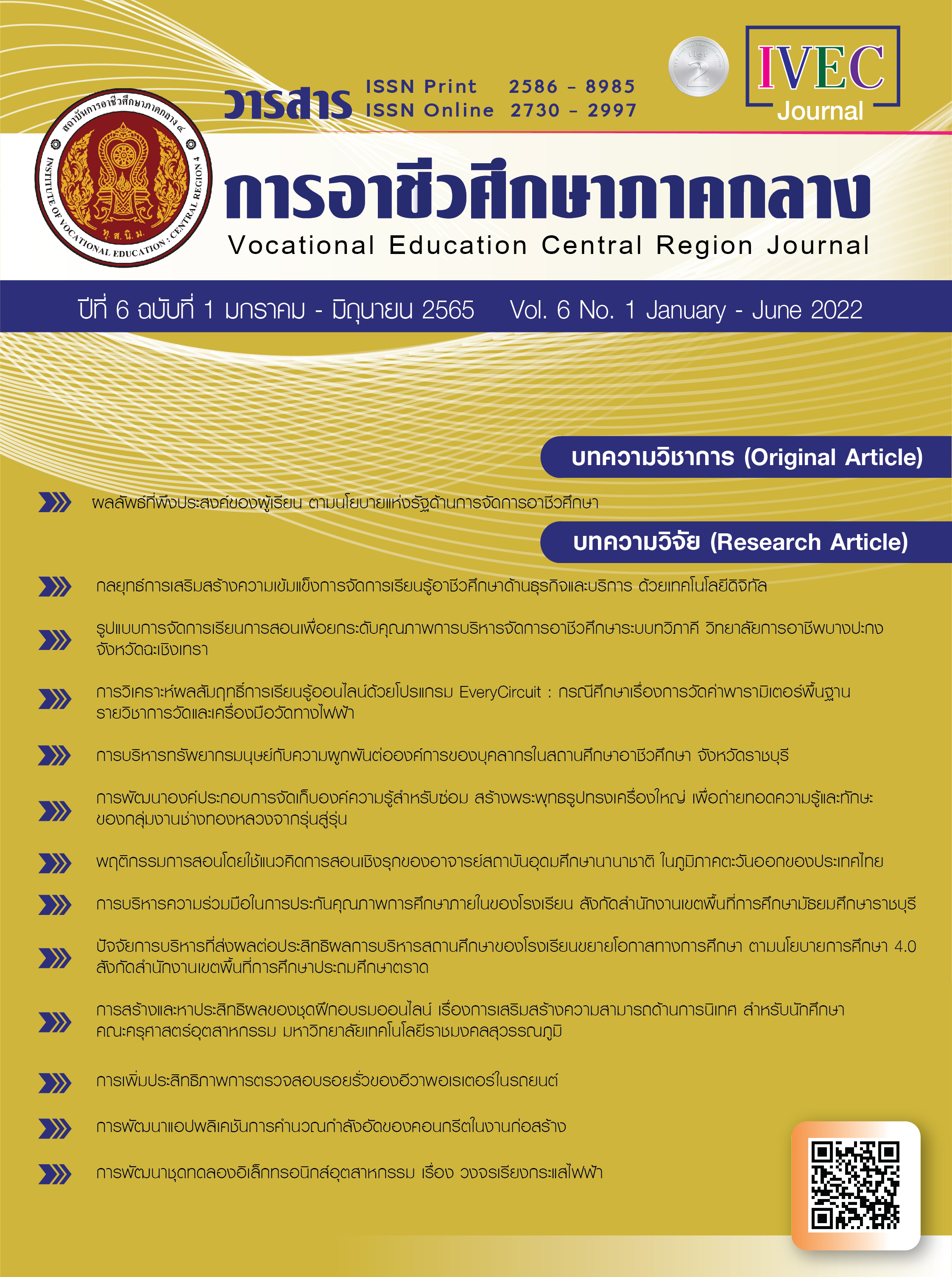The Development of the Accumulated Knowledge for Repairing and Creating the Great Buddha Statues in Royal Attire for the Passing of Knowledge and Skills in Royal Goldsmithing to the Next Generations
Main Article Content
Abstract
The development of the content from the accumulated knowledge for repairing and creating the Great Buddha statue in royal attire in order to pass knowledge and skills in royal goldsmithing to the next generations comprises of 2 phases of operation. Phase 1 started with determining the organization of the content from the accumulated knowledge for repairing and creating the Great Buddha statue in royal attire. The accumulation of knowledge was conducted in documentary form comprising of 4 parts of the content including 1) the accumulation of knowledge on the jewelry’s pattern design for repairing the Great Buddha statue in royal attire in case the original work exists 2) the accumulation of knowledge on the jewelry’s pattern design for creating the Great Buddha statue in royal attire 3) the accumulation of knowledge on the process of analyzing materials and technical techniques for repairing the Great Buddha statue in royal attire and 4) the accumulation of knowledge on the jewelry creation for repairing and creating the Great Buddha statue in royal attire.
Phase 2 started with submitting the results of the accumulation of knowledge in documentary form to 7 experts in repairing the royal fine arts for evaluation with the evaluation results of the 4 parts consisting of 1) the evaluation results of the overall appropriateness on the accumulation of knowledge on jewelry’s pattern design for repairing the Great Buddha statue in royal attire in case the original work exists were at the highest level ( =5.00) 2) the evaluation results of the overall appropriateness on the accumulation of knowledge on jewelry’s pattern design for creating the Great Buddha statue in royal attire were at the highest level (
= 5.00) 3) the evaluation results of the overall appropriateness on the accumulation of knowledge on the process of analyzing materials and technical techniques for repairing the Great Buddha statue in royal attire were at the highest level (
=4.85) and 4) the evaluation results of the overall appropriateness on the accumulation of knowledge on the jewelry creation for repairing and creating the Great Buddha statue in royal attire were at the highest level (
=5.00).
Article Details

This work is licensed under a Creative Commons Attribution-NonCommercial-NoDerivatives 4.0 International License.
|
บทความ ข้อมูล เนื้อหา รูปภาพ ฯลฯ ที่ได้รับการตีพิมพ์ในวารสาร การอาชีวศึกษาภาคกลาง ถือเป็นลิขสิทธิ์ของวารสารการอาชีวศึกษาภาคกลางหากบุคคลหรือหน่วยงานใดต้องการนำทั้งหมดหรือส่วนใดส่วนหนึ่ง ไปเผยแพร่ต่อหรือเพื่อกระทำการใด ๆ กองบรรณาธิการไม่สงวนสิทธิ์ ในการคัดลอกบทความเพื่อการศึกษาแต่ให้อ้างอิงแหล่งที่มาให้ครบถ้วน สมบูรณ์ สงวนสิทธิ์ โดย สถาบันการอาชีวศึกษาภาคกลาง 4 ที่ตั้ง 90 ถนนเทศา ตำบลพระปฐมเจดีย์ อำเภอเมือง จังหวัดนครปฐม โทรศัพท์ 034 242 856 , โทรสาร 034 242 858 ISSN : 3056-9176 (print) ISSN : 2985-2382 (online) |
References
กนกพร ฉิมพลี. (2555). รูปแบบการจัดการความรู้ภูมิปัญญาท้องถิ่นด้านหัตกรรมเครื่องจักรสาน : กรณีศึกษาวิสาหกิจชุมชน จังหวัดนครราชสีมา. วิทยานิพน์ปรัชญาดุษฎีบัณฑิต คณะพัฒนาสังคมและสิ่งแวดล้อม สถาบันบัณฑิตพัฒนบริหารศาสตร์.
พิสิฐ เจริญวงศ์. (2552). รวมบทความเกี่ยวกับ “การ จัดการทรัพยากรวัฒนธรรม” บทความแนวคิด ประสบการณ์ด้านการจัดการทรัพยากรวัฒนธรรมสากล ตีพิมพ์ในคอลัมน์ “ศิลปะ-วัฒนธรรม” ของหนังสือ “อาทิตย์” รายสัปดาห์ ระหว่างเดือนมกราคม 2536 ถึง มกราคม 2539. กรุงเทพฯ: คณะโบราณคดี มหาวิทยาลัยศิลปากร.
ราชบัณฑิตยสถาน. (2546). พจนานุกรมฉบับราชบัณฑิตยสถาน พ.ศ.2542. กรุงเทพฯ: นานมีบุ๊คส์.
สามารถ เที่ยงพูนวงศ์. (2557). การจัดการความรู้ทางศิลปวัฒนธรรมที่มีอยู่ในชุมชนกรณีศึกษา: วัดใหญ่อินทาราม จังหวัดชลบุรี. วิทยานิพนธ์ปริญญาการศึกษารัฐประศาสนศาสตรมหาบัณฑิต สาขาวิชาการบริหารทั่วไป วิทยาลัยการบริหารรัฐกิจ มหาวิทยาลัยบูรพา.
สายันต์ ไพรชาญจิตร์. (2550). จัดการทรัพยากรทางโบราณคดีในงานพัฒนาชุมชน. (พิมพ์ครั้งที่ 3). กรุงเทพฯ: โครงการหนังสือโบราณคดีชุมชน.
Davenport, Thomas, H. and Prusak, Laurence. (1998). Working Knowledge : How rganiza- tions Manage What They Know. Massachusetts : Harvard Business School Press.
Patterson, C. A. Cognitive Feedback as a Tool for Knowledge Acguisition: Naval ostgraduate Wiggins Grant and McTighe Jay. (1998). Understanding by design. Prentice Hall, Inc.
Wiggins, G, & McTghe, J. (1998). Understanding by design. Hoboken, New Jersey : Prentice Hall.


